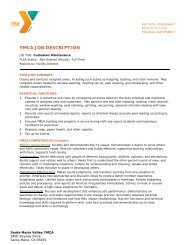Child Care Parent Handbook - Santa Maria Valley YMCA
Child Care Parent Handbook - Santa Maria Valley YMCA
Child Care Parent Handbook - Santa Maria Valley YMCA
You also want an ePaper? Increase the reach of your titles
YUMPU automatically turns print PDFs into web optimized ePapers that Google loves.
Special Situations<br />
In situations that indicate professional help may be necessary, a referral to a professional resource in the community can<br />
be made.<br />
Behavior Management<br />
The safety of a child is the highest priority for setting behavior management procedures.<br />
• When a child has a serious discipline problem, (on any ONE occasion), the parent may be called by staff to request<br />
that the child be picked up within one half hour of the call. Hitting another child, biting, threatening or intimidating<br />
others, injuring another child or staff member or runs from the program center is a serious discipline problem.<br />
• Should it be decided by <strong>YMCA</strong> staff that a child poses a serious discipline problem, the child may be suspended from<br />
the program for a period of 1-5 days, or may be removed from the program entirely.<br />
• The <strong>YMCA</strong> child care program follows all school rules and policies. If a child is suspended from school, he or she is<br />
not allowed to attend the <strong>YMCA</strong> program during the entire time of the suspension.<br />
<strong>YMCA</strong> <strong>Child</strong> Abuse Prevention<br />
The <strong>YMCA</strong> maintains a policy of <strong>Child</strong> Abuse Prevention practices, which include procedures, related to:<br />
• Employee reference checking, hiring criteria, and fingerprinting;<br />
• Training and supervision requirements for staff;<br />
• Staff relationships with children;<br />
• Unscheduled site visitation by <strong>YMCA</strong> supervisory staff and Board.<br />
These policies are enacted to protect parents, children, and <strong>YMCA</strong> staff members from actual occurrences of child abuse<br />
as well as allegations of abuse.<br />
<strong>Child</strong> Abuse Reporting<br />
Section 11166 of the California Penal Code requires any child care custodian, medical practitioner, or employee of a child<br />
protective agency who has knowledge of or observes a child in his or her professional capacity or within the scope of his<br />
or her employment who he or she knows or reasonably suspects has been the victim of child abuse, to report the known<br />
or suspected instance of child abuse to a protective agency immediately or as soon as practically possible by telephone<br />
and to prepare and send a written report thereof within 36 hours of receiving the information concerning the incident.<br />
“<strong>Child</strong> <strong>Care</strong> Custodian” includes teachers, licensed day care workers, administrators, or community care facilities licensed<br />
to care for children, foster parents, and group home personnel.<br />
BITING POLICY<br />
<strong>Parent</strong>s and caregivers are often frustrated by this experience, as it can be both frightening and painful for the children<br />
involved. The following includes some of the reasons why a child may bite. In addition, we have listed the steps we take<br />
here at the center to prevent or respond to a biting situation. We hope this helps to alleviate any concerns you may have.<br />
WHY BITE?<br />
A child may bite for a number of reasons, which might include:<br />
Teething-As two year molars begin to come in, many children bite on an object to try and relieve discomfort. <strong>Child</strong>ren,<br />
who have never bitten others, frequently start to during teething. They are “thinking (acting) with their mouth”, so to speak,<br />
as its presence makes itself felt!<br />
Mimicking- Just as children imitate one another in silly actions and noises, they also imitate more serious behaviors.<br />
Language Frustration- Unable to clearly express their needs verbally, biting may seem to be quick, easy way to get a<br />
message across. It may or may not be, to defend a possession or in response to aggression. Biting may become another<br />
form of a child testing a way to “make things happen.”<br />
8




